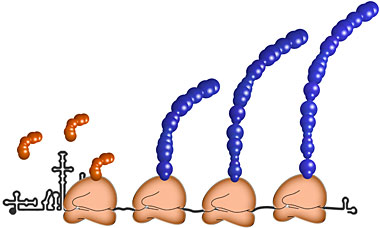A new study led by Valeria Lulla and Andrew Firth from the Division of Virology has just been published in Nature Microbiology.
Enteroviruses comprise a large group of mammalian pathogens that includes poliovirus. Pathology in humans ranges from sub-clinical to acute flaccid paralysis, myocarditis and meningitis. Until now, the eleven viral proteins were thought to derive from proteolytic processing of a single polyprotein encoded in a long open reading frame (ORF) encompassing most of the ~7500-nucleotide virus genome. By analyzing patterns of nucleotide substitutions among >3000 enterovirus genome sequences, the authors predicted that a short upstream open reading frame (uORF) encodes an additional virus protein, termed UP ("uORF protein"). Using a range of classical molecular biology and virology techniques, the authors showed that the protein was produced during infection with a model enterovirus, echovirus 7. Ribosome occupancy of the uORF was studied in exquisite detail via ribosome profiling - a high throughput sequencing technique for footprinting translating ribosomes at single-nucleotide resolution. In collaboration with Nicola Stonehouse's group (University of Leeds), the authors were able to extend these studies to poliovirus type 1 (the most common poliovirus serotype) and EV-A71 (one of the major causative agents of hand, foot and mouth disease). To investigate the function of the UP protein, the authors turned to a differentiated human intestinal organoid system in collaboration with the groups of Matthias Zilbauer (Department of Paediatrics) and Ian Goodfellow (Division of Virology). This work revealed that the UP protein facilitates virus release from membranous components during viral growth in gut epithelia - the initial site of viral invasion into susceptible hosts. These findings overturn the 50-year-old dogma that enteroviruses use a single-polyprotein gene expression strategy, and have important implications for understanding enterovirus pathogenesis and vaccine design.

https://www.nature.com/articles/s41564-018-0297-1
Featured on "This Week in Virology": http://www.microbe.tv/twiv/twiv-522/
An Upstream Protein-Coding Region in Enteroviruses Modulates Virus Infection in Gut Epithelial Cells
Valeria Lulla*, Adam M. Dinan, Myra Hosmillo, Yasmin Chaudhry, Lee Sherry, Nerea Irigoyen, Komal M. Nayak, Nicola J. Stonehouse, Matthias Zilbauer, Ian Goodfellow, Andrew E. Firth* (2018)
The project was funded by the Wellcome Trust and the European Research Council.

